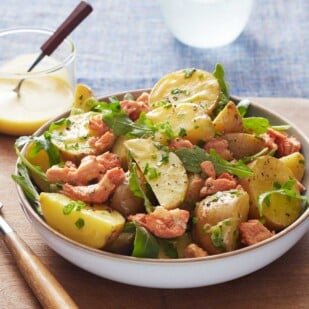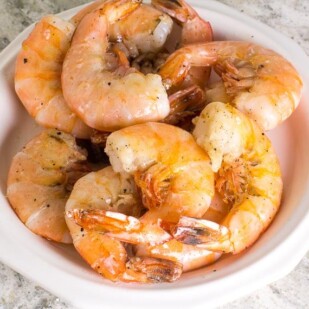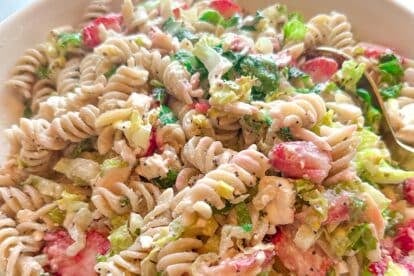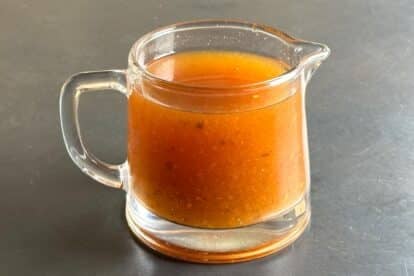Note: This post may include affiliate links. Please see our complete disclosure here.
Warm Salad? YES!
Have you ever though of eating warm salad? This version is going to convert you!
Eat In My Kitchen by Meike Peters is a book that beckons the reader to cook and eat. Maybe with a friend or two, perhaps for a crowd, but it very much welcomes you into the kitchen and into Meike’s world. She has brought us this warm salad of sautéed carrots with lemon and mint.
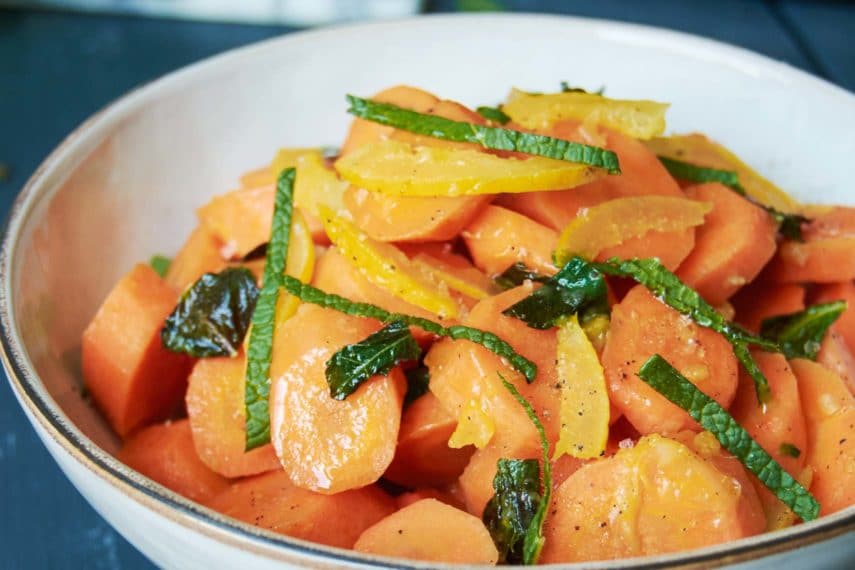
Her view of food is creative but not fussy, earthy and approachable, such as with this featured recipe for Warm Salad of Sautéed Carrots, Preserved Lemon, and Mint. She took the photos for the book as well and they show vivid saturated colors of food that invite you to dig in.
You might know her from her blog Eat in My Kitchen, which she launched with a bang by posting a new recipe every single day for a year. She lives in Berlin and spends time in Malta, where she has family.
Indeed her recipes have a European flare but they adapt beautifully to our kitchens where fresh produce and bold uses of herbs and spices are appreciated.
How Do You Make Warm Salad?
Maybe you have never thought about the concept of a warm carrot salad before. This one will change your mind. Crisp tender cooked carrots, the bracing acidity from the lemon and the bright herbaceous mint combine to be more than a sum of its parts.
The book offers much inspiration for the FODMAPer such as a Cucumber, Arugula and Orange Salad with Turmeric and Mint, Sautéed Endive with Balsamic Butter and Marjoram, Mediterranean Mashed Potatoes with Coriander Oil and many recipes that need some tweaking in the garlic and onion department, but would be very easily adapted to the low FODMAP diet, such as Beef Shank and Caponata Stew and Brungiel Mimli (Maltese Bolognese Stuffed Eggplant.
She offers a chapter on desserts as well as one on savory baking. The final chapter in the book, titled Meet in Your Kitchen, features some of her food writer friends where she profiles them with mini interviews and a recipe each.
This recipe does work best with preserved lemons, which you can buy or make. We have a Preserved Lemon recipe for you to try. They are simply a combination of lemons and salt and if you have some around, you will find many uses for them.
Eat in My Kitchen, by Meike Peters. Published by Prestel, 2016. All photography © Meike Peters. Featured with permission.
The following is from Meike’s recipe headnote:
I regret that I experienced the salty-sour deliciousness of Moroccan preserved lemons so late in my culinary life. My aunt Ursula introduced me to this North African delicacy when she bought a tiny jar from the gourmet section of one of our favorite Berlin food stores.
Despite her excitement, the price almost made her fall over. I got absolutely hooked on them, so much so that it could have caused a noticeable gap in my bank account. Instead, I decided to try making our favorite new discovery at home. It’s not easy to find the small, thin-skinned lemons used in Morocco, so I had to be a bit experimental, but with a few strategic cuts into the peel, regular lemons work just as well.
After weeks of patience, I was rewarded with stunning results. Juicy preserved lemon is quite salty, but in a very pleasant way and it’s now a frequent addition to my vegetables, lamb, and even pizza—with chèvre, it’s fantastic. And whenever a dish needs more than just a hint of citrus, I always turn to preserved lemon to add a strong, exotic touch.
Fresh mint goes very well with it, especially when there are crunchy sautéed carrots on the plate.
This salad can be served as a side—it’s delicious with the Spiced Braised Lamb Shanks—but there’s something very satisfying about a single golden bowl of lemony carrots at lunch.
You can make or buy preserved lemons, or use a squeeze of lemon juice and a bit of zest instead.
Let’s Explore Warm Salad!
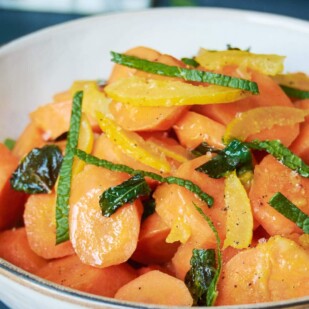
Warm Salad of Sautéed Carrots, Preserved Lemon, and Mint
This Warm Salad of Sautéed Carrots, Preserved Lemon, and Mint is a bright and intriguing side dish to add to your low FODMAP repertoire.
Ingredients:
- Olive oil
- 14 ounces (400 g) peeled carrots, thickly sliced
- 1/4 preserved lemon, very thinly sliced
- 1 teaspoon liquid from the preserved lemons, plus more to taste
- Flaky sea salt
- Ground pepper
- 15 fresh mint leaves, thinly sliced
FOR THE TOPPING:
- 2 fresh mint leaves sliced
Preparation:
-
In a medium saucepan, heat a generous splash of olive oil over medium-low heat. Add the carrots, along with the preserved lemon and its liquid. Season with a little flaky sea salt and pepper, cover the pan, and cook for about 3 minutes or until the carrots are al dente. Stir in the mint and season to taste with flaky sea salt, pepper, and more of the liquid from the preserved lemons.
-
Sprinkle with additional mint, and serve warm or cold.
Notes:
Tips
- Make sure you haver made the preserved lemons first, for have commercially prepared ones on hand. And then, with any extra, try our Moroccan Chicken!
Nutrition
All nutritional information is based on third-party calculations and should be considered estimates. Actual nutritional content will vary with brands used, measuring methods, portion sizes and more. For a more detailed explanation, please read our article Understanding The Nutrition Panel Within Our Recipes.

